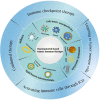Advances in Nanotechnology-Based Immunotherapy for Glioblastoma
- PMID: 35651605
- PMCID: PMC9149074
- DOI: 10.3389/fimmu.2022.882257
Advances in Nanotechnology-Based Immunotherapy for Glioblastoma
Abstract
Glioblastoma (GBM) is the most aggressive type of brain tumor. Despite the multimodal therapies, the effectiveness of traditional treatments is not much satisfying. In recent years, immunotherapy has become the focus of tumor treatment. Unlike traditional treatments that directly target tumor cells, immunotherapy uses the body's immune system to kill tumors. However, due to the severe immunosuppressive microenvironment of GBM, it generally has a poor response to immunotherapy. In addition, the existence of the blood-brain barrier (BBB) also compromises the immunotherapeutic efficacy. Therefore, effective immunotherapy of GBM requires the therapeutic agents to not only efficiently cross the BBB but also relieve the strong immunosuppression of the tumor microenvironment of GBM. In this review, we will first introduce the CNS immune system, immunosuppressive mechanism of GBM, and current GBM immunotherapy strategies. Then, we will discuss the development of nanomaterials for GBM immunotherapy based on different strategies, roughly divided into four parts: immune checkpoint therapy, targeting tumor-associated immune cells, activating immune cells through immunogenic cell death, and combination therapy, to provide new insights for future GBM immunotherapy.
Keywords: blood-brain barrier; glioblastoma; immunotherapy; nanomaterial; nanotechnology.
Copyright © 2022 Tang, Zhang and Liu.
Conflict of interest statement
The authors declare that the research was conducted in the absence of any commercial or financial relationships that could be construed as a potential conflict of interest.
Figures
Similar articles
-
The CNS and the Brain Tumor Microenvironment: Implications for Glioblastoma Immunotherapy.Int J Mol Sci. 2020 Oct 5;21(19):7358. doi: 10.3390/ijms21197358. Int J Mol Sci. 2020. PMID: 33027976 Free PMC article. Review.
-
Immunotherapy for glioblastoma: current state, challenges, and future perspectives.Cell Mol Immunol. 2024 Dec;21(12):1354-1375. doi: 10.1038/s41423-024-01226-x. Epub 2024 Oct 15. Cell Mol Immunol. 2024. PMID: 39406966 Free PMC article. Review.
-
Immune Escape in Glioblastoma Multiforme and the Adaptation of Immunotherapies for Treatment.Front Immunol. 2020 Oct 15;11:582106. doi: 10.3389/fimmu.2020.582106. eCollection 2020. Front Immunol. 2020. PMID: 33178210 Free PMC article. Review.
-
Hypoxia within the glioblastoma tumor microenvironment: a master saboteur of novel treatments.Front Immunol. 2024 Jun 26;15:1384249. doi: 10.3389/fimmu.2024.1384249. eCollection 2024. Front Immunol. 2024. PMID: 38994360 Free PMC article. Review.
-
Extrinsic factors associated with the response to immunotherapy in glioblastoma.Cancer Lett. 2021 Jul 28;511:47-55. doi: 10.1016/j.canlet.2021.04.018. Epub 2021 Apr 29. Cancer Lett. 2021. PMID: 33933551
Cited by
-
Nanomaterials-Based Novel Immune Strategies in Clinical Translation for Cancer Therapy.Molecules. 2023 Jan 26;28(3):1216. doi: 10.3390/molecules28031216. Molecules. 2023. PMID: 36770883 Free PMC article. Review.
-
Cancer nanomedicine in preoperative therapeutics: Nanotechnology-enabled neoadjuvant chemotherapy, radiotherapy, immunotherapy, and phototherapy.Bioact Mater. 2022 Dec 16;24:136-152. doi: 10.1016/j.bioactmat.2022.12.010. eCollection 2023 Jun. Bioact Mater. 2022. PMID: 36606253 Free PMC article. Review.
-
An Update on Emergent Nano-Therapeutic Strategies against Pediatric Brain Tumors.Brain Sci. 2024 Feb 18;14(2):185. doi: 10.3390/brainsci14020185. Brain Sci. 2024. PMID: 38391759 Free PMC article. Review.
-
Application of Carbon Nanomaterials to Enhancing Tumor Immunotherapy: Current Advances and Prospects.Int J Nanomedicine. 2024 Oct 26;19:10899-10915. doi: 10.2147/IJN.S480799. eCollection 2024. Int J Nanomedicine. 2024. PMID: 39479174 Free PMC article. Review.
-
Opportunities to Modulate Tumor Ecosystem Toward Successful Glioblastoma Immunotherapy.Cancer Sci. 2025 Jun;116(6):1482-1499. doi: 10.1111/cas.70052. Epub 2025 Mar 23. Cancer Sci. 2025. PMID: 40123277 Free PMC article. Review.
References
Publication types
MeSH terms
LinkOut - more resources
Full Text Sources
Medical



